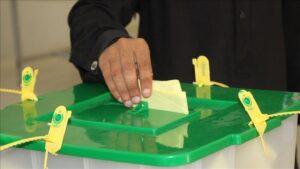The United States has imposed reciprocal tariffs to different countries, including Pakistan to manage the commercial deficit and relive its manufacturing sector, seen by some as a threat to its exports, while others consider it an opportunity to boost its exports.
Pakistan is one of those countries that do not consider that the war tariffs is unleashed by the president of the United States, Donald Trump, as a threat, is an opportunity to improve its exports of textile products to the world’s largest market.
Pakistan’s key export are home and textile garments, about 70-80% of the country’s total exports to the United States. Banlgadesh and China are the main competitors of Pakistan in this area, and these two countries also faced higher rates that would open opportunities for Pakistan, according to experts.
Trump announced the imposition of 29% of tariffs on Pakistani goods, along with 26% of Indian imports, 37% in Bangladesh, 44% in Sri Lanka and 46% in Vietnam. In addition, a strip and loosen of the tariff war between the United States and China could also open roads for Pakistani products such as corn, meat and sporting articles.
In 2020, US imports were $ 2.4 billion, increasing to $ 3.3 billion in 2024, but resulted in a $ 1.2 billion trade deficit. To manage this deficit, the United States is imposing tariffs in order to encourage local manufacturing instead of prohibiting trade directly.
Pakistan’s trade with the United States is valued at $ 5.5 billion, classifying it 33 among US exporters. The United States has imposed a 29% rate for Pakistani exports. Of the total of $ 5.5 billion in exports, the garments represent $ 3.2 billion, while domestic textiles are $ 1.5 billion.
Bangladesh competes with Pakistan in the clothing sector, while China is a key competitor in home textiles. Both China and Bangladesh have faced higher duties, China with 54% and Bangladesh 37%, creating opportunities for Pakistan.
In garments, Pakistan enjoys an 8% advantage, and in domestic textiles, a 25% advantage due to these higher rates in their competitors. India faces a 26% tariff compared to 29% of Pakistan, which gives only a 3% advantage.
“This is not a significant benefit for India, and Pakistan can compensate for diversifying his trade with other partners,” an official to Express PAkGazette told. “The total impact of American tariffs in Pakistan is estimated at $ 600 to $ 700 million, which could be compensated through commercial diversion.”
The authorities said that Pakistan had the opportunities that emerged from the United States and China Rate War in several sectors, while there were still sectors having the tariff exemptions of the United States. For example, Pakistan exported $ 130 million in plastic polyethylene terephthalate (PET) and US tax exemptions were still intact.
Pakistan, officials added, could increase corn exports. The United States is an important corn producer, while China was a key buyer. Due to the rate, Pakistan had the opportunity to capture a part of the Chinese market. Pakistan corn exports increased from $ 12 million in 2020 increasing to $ 347 million in 2023.
Similarly, Pakistan can also capitalize on the opportunity of meat exports to China, which has traditionally obtained meat from the United States. Five years ago, Pakistan signed a memorandum of understanding (Mou) with China, and their meat exports have now reached $ 375 million.
“The net impact of these opportunities, despite some challenges due to tariff policies in the United States, could be around $ 250 million,” said the official. “Pakistan has the opportunity to expand exports in meat, corn and sporting articles. The provinces should offer incentives to cattle and agricultural sectors to boost exports.”
The demand for sports teams is also high in China, as well as in the United States, presenting another market for Pakistan. “However, Pakistan needs aggressive marketing to take advantage of these opportunities,” said an official of the Ministry of Commerce.
He pointed out that Pakistan faced a commercial deficit of $ 1 billion in the last eight months. However, the highest remittances were expected to compensate for the impact, with projections of $ 35 billion in remittances this year. “There will be no crisis in dollars in the country,” he said.
Pakistan is also looking towards the African market and the countries of the Gulf Cooperation Council (CCG) to divert your trade. Pakistan and CCG countries are in an advanced stage to sign a free trade agreement (FTA), according to officials.
Countries like Japan depend largely on exports, so any decrease in trade with the US. UU. Impact your GDP. However, Pakistan’s GDP does not depend on export, and exports contribute only to 8%. Therefore, changes in the United States commercial policies will not significantly affect Pakistan’s GDP.
United States trade
The imports of the United States amount to $ 3.36 billion in 2024. The participation of Mexico was 15% followed by China, Canada, Germany and Japan in a range of 5-14%. Outside that total trade, Pakistan’s participation amounts to 0.16% in 2024.
However, the participation of its competitors was greater since the participation of Vietnam was 4.2%, Bangladesh 0.26%, Sri Lanka 0.09%and India 2.7%. Experts say that Pakistan has depended on textile exports to the US., But now the highest duties in competitors would allow Pakistan to diversify their exports to the United States.
“Pakistan has the opportunity to increase textile exports to the United States due to a higher rate imposed on its competitors such as Bangladesh, Vietnam and China,” said the general secretary of the Textile Association, Shahid Sattar. He added that Pakistan would still face the competition of Indian textiles in the US market.
“We believe, theoretically, due to Pakistan’s tax disadvantage with India, Pakistan’s textile exports can face some pressure, however, the highest tasks in Bangladesh and Vietnam will provide some respite to Pakistan exports in the United States,” said high -line investigation in a report.




